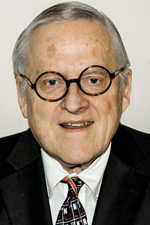Biography

Walter D. Loveland was born in 1939 in Chicago, Illinois, and grew up in Berwyn, a blue-collar suburb of the city. A strong student, Loveland originally planned to attend a vocational school and become an electrician. Encouraged by a high school guidance counselor, Loveland applied to a handful of universities instead, and wound up enrolling at the Massachusetts Institute of Technology in 1957.
At MIT Loveland began as an electrical engineer, but switched his major to chemistry during his sophomore year. A class taught by Charles Coryell stimulated Loveland's interest in nuclear chemistry, and the guidance of his advisor, nuclear chemist Glen E. Gordon, also proved influential. Loveland graduated from MIT in 1961 and, at Gordon's urging, moved on to the University of Washington to continue his studies. Loveland completed his Ph.D in 1966, during which time he also met and married his wife, Pat.
His stint at Washington completed, Loveland and his wife moved back to Chicago, where Walter conducted post-doctoral work at the Argonne National Laboratory under the direction of John Huizenga. The couple remained there for two years but, at Pat's urging, they returned to the west coast in 1968, when Walter accepted a position - initially as a researcher and later as a faculty member - at Oregon State University.
In his early years at OSU, Loveland focused his research on topics in both environmental and nuclear chemistry. After earning tenure, Loveland decided to narrow his research agenda to nuclear chemistry, and subsequently began a long and fruitful collaboration with Glenn Seaborg at the University of California, Berkeley. Concentrating primarily on the chemistry of super-heavy elements, Loveland and Seaborg worked together for twenty-three years, the partnership ending with Seaborg's death in 1999. During this time, Loveland made frequent trips to the Bay Area on weekends and during breaks in the school year; during terms where he had no teaching responsibilities at OSU, Loveland would establish residence in Berkeley.
In 1978 Loveland presented a paper to the Division of Nuclear Physics of the American Physical Society that changed the direction of most research being done on relativistic heavy ions. Later, during the 1980s, Loveland pioneered the use of radioactive beams in heavy-element synthesis. In 1982, Nuclear Chemistry, a book co-authored with Seaborg, was published. His next book, also co-written by Seaborg, was titled The Elements Beyond Uranium and published in 1990. Loveland's most recent book, Modern Nuclear Chemistry, came to print in 2006.
In the early 1990s, Loveland was involved with a group at Berkeley that attempted to synthesize element 110. Though they believed that they had succeeded in creating the element, they were not able to confirm their data, and credit for discovering element 110 ultimately went to a German team. In 1999, while still a professor at OSU, Loveland was part of a research team at the Lawrence Berkeley National Laboratory that announced the discovery of two new elements, numbers 116 and 118, results that were retracted two years later.
In 2002 Loveland served as chair of the American Chemical Society's Division of Nuclear Chemistry and Technology. The following year, he and his colleagues experimentally confirmed the discovery of element 110. In 2012 he organized an ACS symposium to celebrate the 100th anniversaries of the birth of both Glenn Seaborg (1912-1999) and Charles Coryell (1912-1971). Two years later, he received the Glenn T. Seaborg Award for Nuclear Chemistry from the ACS for his contributions to the understanding of super-heavy elements and heavy-element synthesis. Loveland remains a full professor at Oregon State University, where his research group continues the "search for new phenomena at the limits of nuclear stability."

